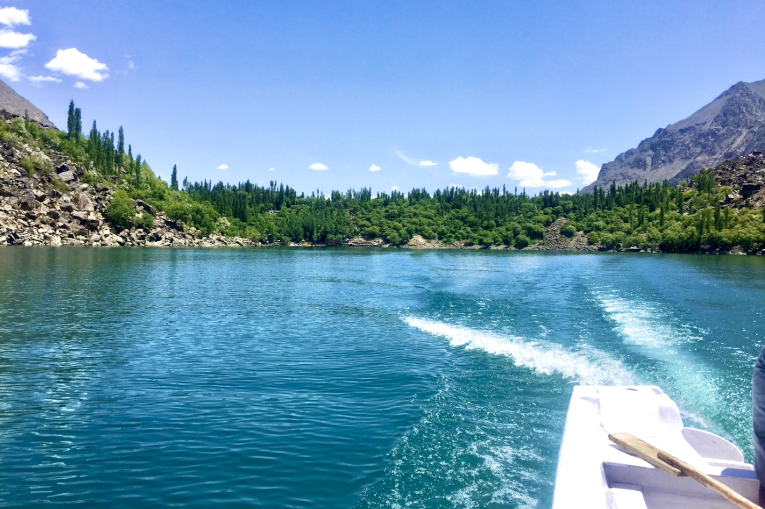
The world seems to be drowning, sooner than we expect. Nature is now taking its revenge, but are humans truly the victims? The recent floods in Pakistan and its neighboring country India are the practical examples we are witnessing. In the history of Pakistan, it is for the first time that the Ravi, Chenab and Sutlej rivers are overflowing simultaneously. Flash floods followed as India released water, causing the dams to overflow. The low-lying areas had to be evacuated immediately. Hundreds of people have been washed away, while millions are displaced across the country. Major districts and cities of Punjab, including Kasur, Narowal, Sahiwal, Sialkot, Bahawalpur and Multan, lie submerged beneath the rising water. The urban infrastructure have been ravaged; the plight of the rural localities is far worse. Notably, the Kartarpur corridor, a historical sanctuary of profound significance for the Sikh community, was also inundated by the deluge.
Triggered by torrential monsoon rains, intensified by climate change, cataclysmic floods and landslides sternly smote the mountainous regions of Khyber Pakhtunkhwa and Gilgit Baltistan. Avenues, bridges, schools and health facilities were swept away. Thousands of houses and infrastructure were destroyed. Access to remote villages was cut off. Cloudbursts, a very rare phenomenon, cost the Buner and Shangla districts more than 400 lives and left many more injured and homeless. The same phenomenon unleashed flash floods and landslides in India’s Kishtwar district and Uttarakhand. Not only the urban infrastructure, but the mountainous infrastructure crumbled to ruin in both countries.
Once Drowned, Forever Lost
Over 8,400 villages have been affected by the recent flooding in Pakistan. Entire villages have been reduced to nothing. Agriculture contributes 24% to the country’s GDP, while approximately 37.4% of the workforce relies on farming. Over 890,000 hectares of farmland have been swamped, jeopardizing both food security and the national economy. More than 5,400 livestock have perished. The calamity crippled livelihoods, especially in rural communities. They not only lost their livestock, harvest, and homes, but also their loved ones. The survivors of the 2022 floods who were struggling to recover have now been rendered even more vulnerable.
It is heartbreaking to witness the videos and news circulating on social media showing the extreme vulnerability of the people. Critical infrastructure, including the Karakorum Highway and other transport routes, became non-operational due to landslides, causing trade disruptions and a major blow to the tourism industry. It was not just houses that were destroyed, but dreams; not just schools, but futures; not just walls of brick and cement, but the hard-earned money and the livelihood of countless families.
Inept Governance
The frequent flooding in Pakistan reflects a chasm in the preparedness and response of the government and the National Disaster Management Authority (NDMA). India, violating the 65-years-old Indus Water Treaty, did not deliver adequate information, which intensified the floods in Punjab. Pakistan should have anticipated this vengeful act of the hostile nation and invested proactively to build more dams, ponds and small reservoirs to store excess water in different regions of the country under such climatic phenomena. The government and NDMA undertook measures to alleviate the disaster’s impact, but they could not recover the loss the people had to endure.
On short notices from PDMA and the local authorities, people were reluctant to abandon their homes, properties and lifelong savings-even at the risk of their lives. More than 700 relief camps and hundreds of medical camps were promised to provide shelter, food, clean water and medicines, but the management failed to cover all the areas. In many places, the setups were done for mere showing-off and were later removed. No proper checks and balances reflected that the system is corrupted, with no accountability and even no basic humanity.
The cases of water-borne diseases like dengue, malaria, skin infections, and snakebites rose significantly. Humanitarian partners, including local and international NGOs, UN agencies and UNICEF, provided hygiene kits, winter kits, food, water and medical assistance to the sufferers, but could not reach all impacted areas. Providing aid and connecting to the most vulnerable remote villages was given priority, but still a lot more funding is required for debris clearance and rehabilitation of water schemes and bridges. Although electricity was deliberately cut off in affected zones to prevent electrocution, few such cases were still reported. Furthermore, no public awareness was given to the people to guide them on how to protect themselves throughout such emergencies. The government and authorities failed miserably not only to safeguard the lives and properties, but also the trust of the people.
Human Actions Vs. Nature’ Wrath
What has caused nature to turn against humanity in such a disastrous way? In the hunger for settlement, humans failed to realize that they were playing with nature itself. To build dream cities and expand settlements and infrastructure, the forests, wetlands and other habitats were recklessly converted to farms and conurbations. The Park View Housing Society, established on the riverbed of the Ravi in Lahore, was immersed by the river it tried to claim. The administration, blinded to nature’s call, obstructed the water course, overlooking that nature always finds its way.
Industrial waste and greenhouse gases produced by the burning of fossil fuels cause the Earth’s temperature to rise, leading to extreme weather conditions like cloudbursts, glacier melting and rising sea levels. The glaciers melt to form hazardous lakes, unleashing sudden gushes of water and debris in large volumes. In April 2025, a melted glacier blocked a route in Naran, whilst in June, Gilgit Baltistan suffered from Glacier Lake Outburst Floods (GLOF), causing several fatalities, damage to homes, infrastructure and agriculture land.
Although, Pakistan emits less than 1% to global greenhouse gases, it is among the ten most vulnerable countries affected by climate change. Absence of forests that once absorbed the rainwater and guided it to rivers has worsened the flood conditions. Timber cutting was done to promote agriculture in the northwest regions of Khyber Pakhtunkhwa, such as Swat, Dir and Hazara; however, greenbelt along the river banks was cleared for farming purposes in Sindh. Timber mafia used rivers to transport logs, which damaged the bridges and other infrastructure during floods. Removal of natural sponges, along with climate changes contributed to factors of flash flooding.
To counter these destructive practices, environmental enforcement bodies must be formed, mandating environmental impact assessments before any new construction or industrial projects. Severe penalties and heavy fines must be imposed on individuals and groups conducting illegal deforestation and land-clearing. Green community management programs can help ensure greenbelt protection and reforestation, especially along riverbeds and in upstream catchment areas to preclude torrents. Small-scale glacier monitoring units are needed in vulnerable zones to provide early warnings for GLOF. A specialized policing wing must be launched to crack down on illegal deforestation and timber mafias by conducting on-ground inspection and drone surveillance.
A Deluge of Despair
It may be hard to assimilate, but given the current climatic conditions and increasing frequency and intensity of the natural disasters make it evident that we have scarred our blue planet. If the human patterns continue unchanged, there will be no way back, and human survival itself will be at stake. Around the world, projects have been initiated for the restoration of the environment, yet there is no complete remedy for a ruined Earth. The only thing we can do now is show mercy to our home and to ourselves. More research centers and institutions must be established to analyze climatic patterns and propose sustainable solutions to mitigate and adapt to extreme weather conditions.
The least responsible for climate change are often the ones who suffer more. Global justice demands that the world’s major emitters support vulnerable nations like Pakistan. The world must unite for this cause. Humans need to realize that it is high time we stopped acting imprudently and wake up to reality. These floods and other catastrophic phenomena must serve as an eye-opener, reflecting the cruelty man has inflicted on this once-pure land. We must now worry about our future generations and what legacy we are leaving behind.
Teaser image credit: Author supplied.



